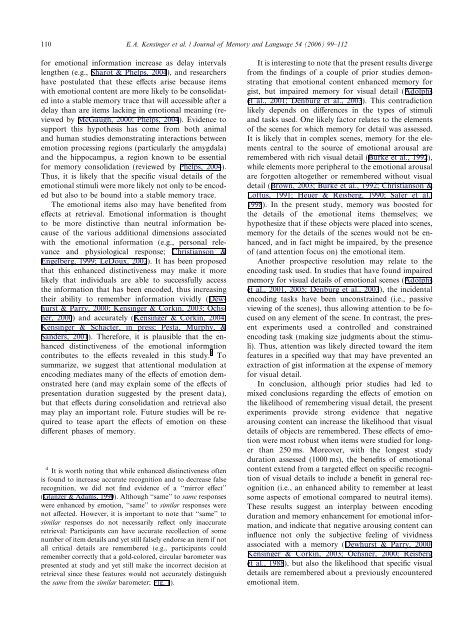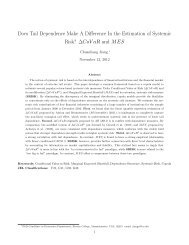Memory for specific visual details can be enhanced by negative ...
Memory for specific visual details can be enhanced by negative ...
Memory for specific visual details can be enhanced by negative ...
You also want an ePaper? Increase the reach of your titles
YUMPU automatically turns print PDFs into web optimized ePapers that Google loves.
110 E.A. Kensinger et al. / Journal of <strong>Memory</strong> and Language 54 (2006) 99–112<br />
<strong>for</strong> emotional in<strong>for</strong>mation increase as delay intervals<br />
lengthen (e.g., Sharot & Phelps, 2004), and researchers<br />
have postulated that these effects arise <strong>be</strong>cause items<br />
with emotional content are more likely to <strong>be</strong> consolidated<br />
into a stable memory trace that will accessible after a<br />
delay than are items lacking in emotional meaning (reviewed<br />
<strong>by</strong> McGaugh, 2000; Phelps, 2004). Evidence to<br />
support this hypothesis has come from both animal<br />
and human studies demonstrating interactions <strong>be</strong>tween<br />
emotion processing regions (particularly the amygdala)<br />
and the hippocampus, a region known to <strong>be</strong> essential<br />
<strong>for</strong> memory consolidation (reviewed <strong>by</strong> Phelps, 2004).<br />
Thus, it is likely that the <strong>specific</strong> <strong>visual</strong> <strong>details</strong> of the<br />
emotional stimuli were more likely not only to <strong>be</strong> encoded<br />
but also to <strong>be</strong> bound into a stable memory trace.<br />
The emotional items also may have <strong>be</strong>nefited from<br />
effects at retrieval. Emotional in<strong>for</strong>mation is thought<br />
to <strong>be</strong> more distinctive than neutral in<strong>for</strong>mation <strong>be</strong>cause<br />
of the various additional dimensions associated<br />
with the emotional in<strong>for</strong>mation (e.g., personal relevance<br />
and physiological response; Christianson &<br />
Engel<strong>be</strong>rg, 1999; LeDoux, 2002). It has <strong>be</strong>en proposed<br />
that this <strong>enhanced</strong> distinctiveness may make it more<br />
likely that individuals are able to successfully access<br />
the in<strong>for</strong>mation that has <strong>be</strong>en encoded, thus increasing<br />
their ability to remem<strong>be</strong>r in<strong>for</strong>mation vividly (Dewhurst<br />
& Parry, 2000; Kensinger & Corkin, 2003; Ochsner,<br />
2000) and accurately (Kensinger & Corkin, 2004;<br />
Kensinger & Schacter, in press; Pesta, Murphy, &<br />
Sanders, 2001). There<strong>for</strong>e, it is plausible that the <strong>enhanced</strong><br />
distinctiveness of the emotional in<strong>for</strong>mation<br />
contributes to the effects revealed in this study. 4 To<br />
summarize, we suggest that attentional modulation at<br />
encoding mediates many of the effects of emotion demonstrated<br />
here (and may explain some of the effects of<br />
presentation duration suggested <strong>by</strong> the present data),<br />
but that effects during consolidation and retrieval also<br />
may play an important role. Future studies will <strong>be</strong> required<br />
to tease apart the effects of emotion on these<br />
different phases of memory.<br />
4 It is worth noting that while <strong>enhanced</strong> distinctiveness often<br />
is found to increase accurate recognition and to decrease false<br />
recognition, we did not find evidence of a ‘‘mirror effect’’<br />
(Glanzer & Adams, 1990). Although ‘‘same’’ to same responses<br />
were <strong>enhanced</strong> <strong>by</strong> emotion, ‘‘same’’ to similar responses were<br />
not affected. However, it is important to note that ‘‘same’’ to<br />
similar responses do not necessarily reflect only inaccurate<br />
retrieval: Participants <strong>can</strong> have accurate recollection of some<br />
num<strong>be</strong>r of item <strong>details</strong> and yet still falsely endorse an item if not<br />
all critical <strong>details</strong> are remem<strong>be</strong>red (e.g., participants could<br />
remem<strong>be</strong>r correctly that a gold-colored, circular barometer was<br />
presented at study and yet still make the incorrect decision at<br />
retrieval since these features would not accurately distinguish<br />
the same from the similar barometer; Fig. 1).<br />
It is interesting to note that the present results diverge<br />
from the findings of a couple of prior studies demonstrating<br />
that emotional content <strong>enhanced</strong> memory <strong>for</strong><br />
gist, but impaired memory <strong>for</strong> <strong>visual</strong> detail (Adolphs<br />
et al., 2001; Denburg et al., 2003). This contradiction<br />
likely depends on differences in the types of stimuli<br />
and tasks used. One likely factor relates to the elements<br />
of the scenes <strong>for</strong> which memory <strong>for</strong> detail was assessed.<br />
It is likely that in complex scenes, memory <strong>for</strong> the elements<br />
central to the source of emotional arousal are<br />
remem<strong>be</strong>red with rich <strong>visual</strong> detail (Burke et al., 1992),<br />
while elements more peripheral to the emotional arousal<br />
are <strong>for</strong>gotten altogether or remem<strong>be</strong>red without <strong>visual</strong><br />
detail (Brown, 2003; Burke et al., 1992; Christianson &<br />
Loftus, 1991; Heuer & Reis<strong>be</strong>rg, 1990; Safer et al.,<br />
1998). In the present study, memory was boosted <strong>for</strong><br />
the <strong>details</strong> of the emotional items themselves; we<br />
hypothesize that if these objects were placed into scenes,<br />
memory <strong>for</strong> the <strong>details</strong> of the scenes would not <strong>be</strong> <strong>enhanced</strong>,<br />
and in fact might <strong>be</strong> impaired, <strong>by</strong> the presence<br />
of (and attention focus on) the emotional item.<br />
Another prospective resolution may relate to the<br />
encoding task used. In studies that have found impaired<br />
memory <strong>for</strong> <strong>visual</strong> <strong>details</strong> of emotional scenes (Adolphs<br />
et al., 2001, 2005; Denburg et al., 2003), the incidental<br />
encoding tasks have <strong>be</strong>en unconstrained (i.e., passive<br />
viewing of the scenes), thus allowing attention to <strong>be</strong> focused<br />
on any element of the scene. In contrast, the present<br />
experiments used a controlled and constrained<br />
encoding task (making size judgments about the stimuli).<br />
Thus, attention was likely directed toward the item<br />
features in a specified way that may have prevented an<br />
extraction of gist in<strong>for</strong>mation at the expense of memory<br />
<strong>for</strong> <strong>visual</strong> detail.<br />
In conclusion, although prior studies had led to<br />
mixed conclusions regarding the effects of emotion on<br />
the likelihood of remem<strong>be</strong>ring <strong>visual</strong> detail, the present<br />
experiments provide strong evidence that <strong>negative</strong><br />
arousing content <strong>can</strong> increase the likelihood that <strong>visual</strong><br />
<strong>details</strong> of objects are remem<strong>be</strong>red. These effects of emotion<br />
were most robust when items were studied <strong>for</strong> longer<br />
than 250 ms. Moreover, with the longest study<br />
duration assessed (1000 ms), the <strong>be</strong>nefits of emotional<br />
content extend from a targeted effect on <strong>specific</strong> recognition<br />
of <strong>visual</strong> <strong>details</strong> to include a <strong>be</strong>nefit in general recognition<br />
(i.e., an <strong>enhanced</strong> ability to remem<strong>be</strong>r at least<br />
some aspects of emotional compared to neutral items).<br />
These results suggest an interplay <strong>be</strong>tween encoding<br />
duration and memory enhancement <strong>for</strong> emotional in<strong>for</strong>mation,<br />
and indicate that <strong>negative</strong> arousing content <strong>can</strong><br />
influence not only the subjective feeling of vividness<br />
associated with a memory (Dewhurst & Parry, 2000;<br />
Kensinger & Corkin, 2003; Ochsner, 2000; Reis<strong>be</strong>rg<br />
et al., 1988), but also the likelihood that <strong>specific</strong> <strong>visual</strong><br />
<strong>details</strong> are remem<strong>be</strong>red about a previously encountered<br />
emotional item.

















